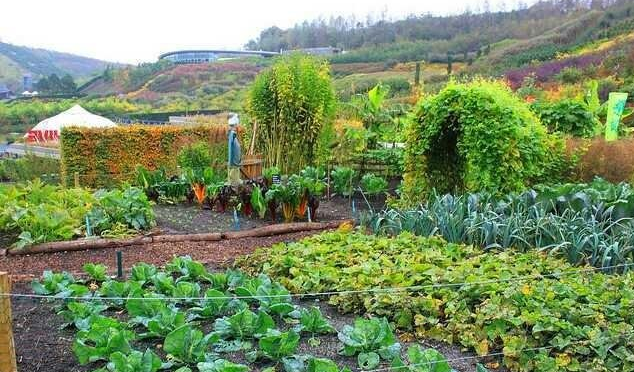The picturesque Kashmir Valley, known for its lush landscapes and rich agricultural heritage, predominantly cultivates apple and rice. While these crops have traditionally been the backbone of the region’s economy, reliance on a monoculture system poses significant risks. Diversified farming, which involves growing a variety of crops including cereals, fruits, and underutilized crops, offers a sustainable alternative that can transform the livelihoods of both marginal and big farmers in the Kashmir Valley.
Kashmir’s agriculture is heavily skewed towards apple orchards and rice paddies. Apples are a major export, contributing significantly to the local economy, while rice is a staple food crop. However, this dependence on a limited range of crops makes farmers vulnerable to market fluctuations, pest infestations, and climate change impacts. Diversifying agricultural practices can mitigate these risks and provide multiple benefits.
Benefits of Diversified Farming
Diversifying crops can provide a steady income throughout the year, reducing dependence on a single crop’s seasonal harvest. For instance, integrating high-value crops such as oats for human consumption, strawberries, nectarines, rapeseed, and buckwheat with traditional apple orchards can ensure continuous revenue streams. Oats, in particular, fetch a market price up to four times higher than other cereals, offering significant profit potential. This approach can protect farmers from price volatility and crop failure, fostering economic resilience.Cultivating a variety of crops ensures a more stable and diverse food supply.
This not only meets the nutritional needs of local communities but also reduces dependency on imported food grains. For marginal farmers, growing a range of crops can directly enhance household food security. Buckwheat and oats, being highly nutritious, can contribute significantly to the dietary needs of the local population.Monoculture farming often depletes soil nutrients and leads to increased pest problems. In contrast, diversified farming practices can improve soil health through crop rotation and intercropping. These methods enhance soil fertility, reduce the need for chemical fertilizers, and promote biodiversity. Additionally, they can help in better water management, crucial for a region with varying precipitation patterns.
Diversified farming can create additional employment opportunities in farming and related sectors such as food processing and marketing. This is particularly beneficial for rural youth and women, providing them with more avenues for income generation and empowerment. The cultivation of high-value crops like strawberries and nectarines can lead to the establishment of local processing units, further enhancing job creation.Integrating underutilized crops with high market and medicinal value, such as saffron, lavender, and medicinal herbs, can open new revenue streams. These crops are often well-suited to the climatic conditions of the Kashmir Valley and can fetch premium prices in domestic and international markets.
The Transformative Potential of Oats for human consumption
Oats, with their high market value and growing demand for human consumption, can significantly change the destiny of farmers in the Kashmir Valley. Currently, the market price of oats is up to four times higher than that of other cereals. This makes oats an exceptionally lucrative crop for farmers to cultivate. By shifting a portion of their land to oat cultivation, farmers can substantially increase their income, ensuring financial stability and reducing the risks associated with reliance on a single crop and this crop declared world health organization (WHO) a future food. The nutritional benefits of oats also mean that there is a consistent demand for this cereal, both locally and globally. As health-conscious consumers seek out nutritious food options, the demand for oats continues to rise, providing a stable and profitable market for farmers. This makes oats not just a crop, but a strategic asset in the push towards diversified farming in the region.
Impacts on Marginal and Big Farmers
Marginal farmers, who typically own smaller plots of land, can significantly benefit from diversified farming. By growing a mix of high-value and underutilized crops, they can optimize their limited resources and enhance productivity. Diversification allows them to hedge against the risks associated with mono-cropping, ensuring a more stable and reliable source of income. Additionally, government schemes and agricultural extension services can support these farmers in adopting new practices and technologies.
For big farmers with larger landholdings; diversified farming offers opportunities to explore agribusiness ventures. They can invest in high-value fruit cultivation, agro-processing units, and direct marketing strategies such as farm-to-table models. This can lead to higher profit margins and the creation of value-added products, further boosting the regional economy. Cultivating crops like rapeseed can also provide raw materials for biofuel production, adding another dimension to their income streams.
Challenges and Solutions
Knowledge and Training: Farmers need access to information and training on diversified farming practices. Establishing agricultural extension services and training programs can bridge this gap. Developing robust market linkages for a variety of crops is essential. This includes improving infrastructure, storage facilities, and transportation networks.Government policies should encourage diversified farming through subsidies, credit facilities, and insurance schemes. Incentives for adopting sustainable practices can also promote widespread adoption.
Diversified farming holds the promise of transforming the agricultural landscape of the Kashmir Valley. By embracing a mix of high-value crops such as oats, strawberries, nectarines, rapeseed, buckwheat, and underutilized crops with medicinal value, farmers can achieve greater economic stability, enhanced food security, and environmental sustainability.
The high market value of oats, in particular, can significantly uplift the economic prospects of farmers, providing a stable and lucrative income source. This shift can uplift both marginal and big farmers, ensuring a resilient and prosperous future for the region’s agrarian community. With concerted efforts from all stakeholders, diversified farming can pave the way for a thriving and sustainable agricultural sector in Kashmir by 2050.
(Author is Scientist- MRCFC-Khudwani, SKUAST- Kashmir. EMAIL ID: [email protected])








